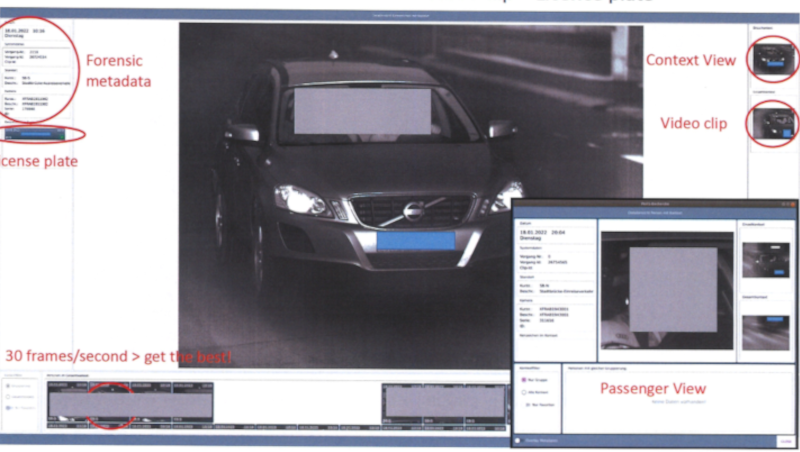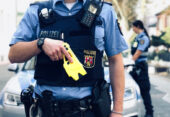In various German states, the police in Saxony have set up a covert camera at the side of the road to identify suspicious persons driving past. Now there are details about the technology, which was first revealed in Berlin.
Investigators in Lower Saxony also use a mobile facial recognition system for undercover surveillance. This was confirmed by a spokesperson for the Hanover Police Directorate (PD). The technology originates from Saxony and was used in a case of gang-related property crime. Its operation had provided “clues about the vehicles used by the people associated with the gang”, said a police spokesperson from Hanover in response to an enquiry from “nd”. These had proved to be “helpful for the parallel conventional surveillance measures”.
The use of such mobile surveillance technology first came to light in Berlin a few weeks ago. In response to a parliamentary enquiry, the Saxon state government stated that it had also used the system in North Rhine-Westphalia, Brandenburg and Baden-Württemberg in addition to Lower Saxony.
System originates from border region
The photos taken secretly in Lower Saxony were reportedly compared with police databases containing images from identification procedures (ED procedures). The spokesperson did not explain which databases were used. It is possible that these are reference files in which only the suspects in the respective proceedings are stored. However, the Lower Saxony state police also have access to the nationwide INPOL system, in which around six million facial images of around four million people are stored. These originate in roughly equal parts from ED treatment or asylum applications.
The police in Hanover cite Section 98c of the German Code of Criminal Procedure (StPO) as the legal basis for the use of the system in Lower Saxony. It regulates the “automatic comparison with existing data” to investigate a criminal offence or to determine the whereabouts of a person wanted in criminal proceedings.
The information from Hanover also reveals details of the secret surveillance technology from Saxony for the first time. As anticipated, it is a mobile version of the “Personal Identification System” (PerIS) developed by the Görlitz police together with the company OptoPrecision from Bremen.
Installed in delivery vans as “PerIS-Mobil”
The PerIS currently operates in five fixed camera columns in Görlitz and Zittau. At the border with Poland, it records facial images and licence plate numbers when people pass by in vehicles. The police in Upper Lusatia also presented the motion-controlled system at a conference organised by the EU border agency Frontex, where they described it as unique in Europe.
Since the end of February 2021, the police in Görlitz have also had a mobile device called “PerIS-Mobil”, which, according to the Saxon state government, has now grown to two vehicles. One is white, the other is orange.
The manufacturer’s website also shows how the system is installed in the van. According to the police in Hanover, around six terabytes of data on faces and number plates are collected every day and analysed using “specially developed complex software”. This means that “tedious scrutinising of individual video clips for relevant data” by officers is “mostly no longer necessary”. All data that is no longer required would be “automatically and irrevocably deleted” after 96 hours.
“Automated detection” also possible in real time
When searching for vehicles, licence plates and people, it is also possible to enter “individual fragments of numbers or letters”, according to Hanover. There, the technology is only used retrogradely, i.e. not in real time. Subject to the legal situation, however, the “automated detection” of faces and licence plate numbers is also possible in a “live mode”. Saxony’s police also explained this in the presentation at Frontex. However, according to a further response to a parliamentary enquiry, the function is not used in their own federal state. According to this, there were only “manual retrograde data comparisons” in Upper Lusatia.
According to the Public Prosecutor’s Office in Berlin, however, such a real-time operation took place there. The basis for the operation was therefore the dragnet search paragraph 98a of the Code of Criminal Procedure (StPO). In the case of a criminal offence of major significance, it allows the data of persons under surveillance to be “automatically compared with other data”. Because the Saxon data protection commissioner was not informed about this, she has now lodged a complaint.
It is also not known from Berlin exactly which reference image data the secret recordings were compared with. In addition to photos from ED procedures, a “meaningful and high-quality photo from social media” can also be used for this purpose, according to the Hanover Police Department.
Image: The mobile PerIS variant is installed in an inconspicuous van and shoots high-resolution images (Police in Saxony /Frontex).





Leave a Reply